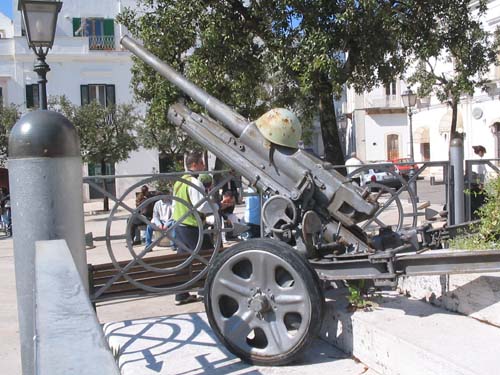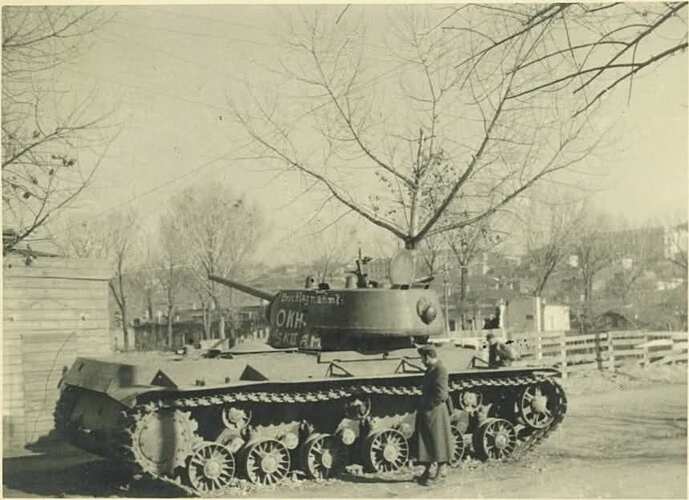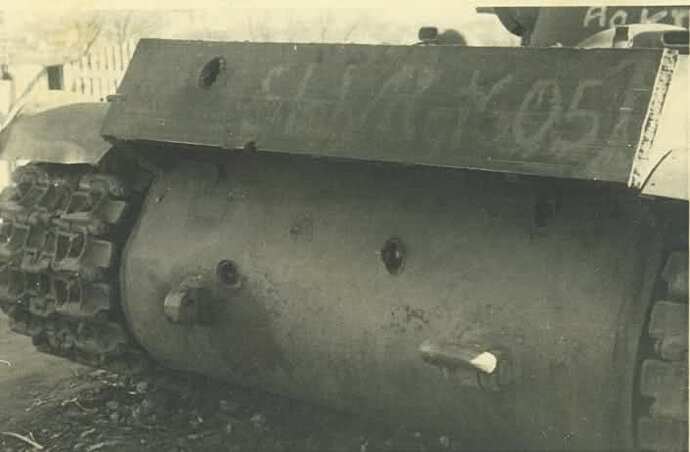Should be no match…
And anyway there was a little possibility for the 47/32.
Surely they know where to shoot, but probably they had to get very closer for those 70mm of rear armour. I think no more than 500 meters with HEAT ammo, and it’s a dangerous low distance. Aniway that’s the result. But btw, are we sure that is a 47/32 effect? :lol:
what is the 47/32 ?
DVX Hello, you are sure it is KV1 was destroyed by Italian troops, because I knew the KV1 very difficult to think that this is a 47/32 which is made of such damage, would you please a little more info on this document.
Amitiés Fred
I just visit Italy from 1935 to 1945 and my doubts were justified, because the 47/32 has a penetration capacity than 4 cm, therefore impossible to penetrate the armor of a KV1.
Amitiés Fred
Hi Fred. Yes, it could appear incredible but it’s possible the 47/32 did the job. Actually I don’t know if really the shots were fired by the 47/32, but I’ve the comparative perforation skills done by the Regio Esercito between the French gun 47/34 of the R35s in service with the Italian army and the our 47/32. Here the comparative list with standard armor piercing ammunitions:
French 47/34
100 m - 83 mm
500 m - 73 mm
1000 m - 62 mm
1500 m - 52 mm
Italian 47/32
100 m - 58 mm
500 m - 43 mm
But with HEAT ammo the penetration force of the 47/32 grew to 115 mm within 500 m.
So, theorically it’s possible that the 47/32 did the job and even from a distance over 500 m, considering the 70mm rear armor of the KV1. Surely the shots are concentrated in rear part of the tank, so who fired knew where to aim and probably where had to aim. With HEAT rounds the 47/32 could do the job in the photo.
This is the 47/32

Here a list of Italian ammunitions. Fred look at page 3, there is a pic of a HEAT round of the 47/32 il proiettile EPS (effetto pronto speciale) a bit rarer than the EP effetto pronto (the more common HEAT round).
Queery about the Cannone da 47/32 M35 (I presume that is what you are discussing)
The 47/32 was in service from the 1930’s onwards. Were they used in the Western Desert and if so when. Looking at that penetration capability of 115mm that would have meant they could penetrate the Matilda II Infantry Tank’s frontal armour which was a maximum of 78mm. When was the HEAT round developed and deployed.
As far as I was aware the Italians had no weapons that could penetrate the Matilda’s frontal or side armour (possibly the Cannone da 90/53 AA weapon if it was in theatre) hence the reason for Matildaitis (similar to the Allies Tigeritis) in some units.
47mm caliber and 32? Lengh of the gun?
Although I was unaware(my crystal ball doesnt have an app for it) of anyone fielding HEAT munitions during WW II (aside from Bazookas, and Panzer Fausts/Schreck,and mines) anyway, the velocity of a gun is unimportant with a heat munition, as apart from getting the round to the target, the high explosive does all the work. I do have my reservations about a 47 mm heat munition, not much of a payload…
Chevan old friend, good to see you!! the designation could mean 47mm bore diameter with a barrel length of 32 calibers (a bit more than 1.5 meters) but it might also mean a 47 mm gun accepted or issued in 1932.
Yes Leccy, but the EP and EPS rounds (HEAT) started to be delivered in late 1941, the Ariete division received the first EP ammos in the Bir el Gobi battle (november-december 1941). In that time the Matildas were no more a complete scare for Italian troops like in 1940. And anyway the HEAT ammo remained rarely at disposal.
Even with HEAT ammo the 47/32 could be effective against a Matilda just around the 500meters, a distance too close to not be easily wiped out by the tanks standing off the range, especially those armed with a 75mm gun but the same Matilda’s 40mm gun too.
Italians didn’t have weapons able to pierce the Matilda armor, exept the heavy fied-artillery. They used some tactics to reduce the danger of the Matildas, like to shoot in the tracks or in the bottom when the tank, that was quite slow, overcame some obstacles.
Even the German PAKs of 37 and 50mm could not do something against the Matilda.
However the 75mm guns with HEAT ammo started to be effective from a good distance, but this kind of ammo was not at disposal before late 1941.
The 90/53 mm AA/AT gun was better than the German 88 and was affective against every Allied tank.
I still have big doubts my dear Chevan, not so much by the caliber of the ammunition, but its speed is only 630 m / s, rather low for a shielding like the KV1, which caused a lot of problem with German tanks, when it appeared on the front, that’s why I wish that DVX tell us the source of this document, we’ll know a little more time.
Amitiés Fred
The source is an album of an autiere (army truck driver). The photo was taken behind the lines, I think he neither could know what exactly happened. Anyway I’m not sure that the 47/32 did it. But with HEAT ammo and from a very close range theorically it was possible.
What other weapon? From the holes can you guess a possible caliber?
I agree with your sense DVX, for indeed if you look at the hole diameter, it seems a little too wide for a round of 47, I would lean more about a round of 75 that can pierce the armor of KV1 .
Amitiés Fred
fred109
It does not matter about the velocity of HEAT rounds to much, the penetration is by a explosive formed slug of metal that burns through the armour. The velocity only comes into effect for the range that the round can reach (higher velocity generally equals longer range).
The Matildas 2pdr had no HE round so was vulnerable to AT weapons later on (there was a HE 2pdr round but it was never issued and was of limited power anyway). The Matilda units First Echelon repair always carried cutting torches with them after the first couple of engagements with Italian artillery, this was because the turrets used to get jammed with shell splinters and AT shot welding between the turret and turret ring.
HEAT munitions breach armor by means of a high velocity jet stream that is formed by the base detonation of the explosive filling. This produces a shockwave within the filling that is focused by the cone shaped depression in the face of the filling. The metal cone liner, which was a later development , could be made of about anything, but early on, steel was the preferred material, with copper coming along sometime after. The liner allowed a longer build up of energy in the wave, and would then deform, and join with the jet stream as it went toward the target. The Jet Stream, not the liner is what does the work of penetrating the armor, the extreme pressure of the stream causing the steel to flow like a viscous liquid. Present day stream velocities exceed 30,000 fps.
An explosivly formed penetrator is a different thing altogether, a mass of Bronze acted upon by the pressure of a high explosive, will take the rough shape of a penetrator, and by its mass, and velocity perf the target much like any other kinetic A.P. munition.
Hi mate, nice to meet you again, my old friend…
Well i have guessed the 32 caliber length of barrel a too short for good speed of shell and for armor penetration abolity. i believe the average barrel length of any effective AT gun began from 50-70 of calibers.
Bonjour mesue Fred:)
Yes the 630 m/s doesn’t look like effective AT speed of shell. But as said our friend Leccy the speed doen’t matter for CUMULATIVE shell. The speed of Panzerfaust hardly exceeded 150 m/s , but it’s penetration ability was outstanding. I still have a doubts , however, the the cumulative ammos really existed for 47/32 barrel in that early period of war ( seem 1941) . It seems for me, and i do share your doubts, this tank was destroyd by that tiny gun. Likely it was a bigger gun, but that fact doesn’t exclude the possibility the Italians might to get training with another guns, trying to hit its’ armor. It was regular practice for all sides of war. I know the Soviet crews also got trainig missions to shoot at destroyed mewly designed germans kittes.Of course unless they had enough ammos for that.
Hello everyone, so I asked on the forum and Italy 1935-45 the answer is not expected, given the poor can not pared qualitées tank of this canon. Remember that the Italians have taken anti-tank guns on Russian notament the 75/46 anti air and to a lesser extent parts 75/27mod 12 and 100/17. To conclude this is what said the Italian Authorities at the time “Le armi anticarro organicamente assegnate allo CSIR (in totale n. 108 pezzi da 47/32) sono sempre stato assolumente inadeguate per qualità e quantità alle particolari esigenzi della scacchiere operativo russo ed alle caratteristiche dei carri medi e pesanti impiegati dall’avversario” (Foglio n. 5209/op. du 5 giugno 1942, Mezzi anticarro, Comando del corpo di spedizione italiano in Russia - Ufficio operazioni.
Friendly Friend
PS : Chevan the word “mesue” in french is “monsieur”, tank’s for this little word in my language.


